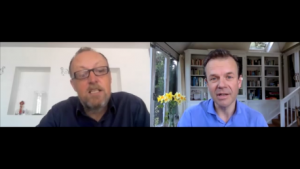I’ve been working in the field of influence and negotiation for nearly twenty years now and I still find it an absolutely fascinating topic and never more so than when exploring it with colleagues in the field.
Last summer I enjoyed a series of conversations with my friend and colleague Luan de Burgh, an expert in the field (although don’t tell him I said that, it will only go to his head) that was a lot of fun. We covered some serious points on the prisoner’s dilemma, increasing trustability and best approaches to influence and persuasion, and all with a lot of friendly banter thrown in. He has a grate sense of humour and even his dog managed to contribute (in fact, contribute more effectively than Luan).
And what was nice was we were able to catch it all on video.
The Prisoner’s Dilemma
You can see the first one here and we spend ten minutes taking the mick out of each other whilst discussing the Prisoner’s Dilemma. There’s a detailed explanation in the video but it’s a fiendish construct because if players follow their own individually optimised strategy, paradoxically they end up worse off. The answer is to optimise their strategy globally rather than individually, but this relies on trust.
So what can you do to increase trust?
The good news is that there are lots of things. Again, there is a lot more information on the video but broadly speaking, it boils down to four principles:
- Be trusting: the research shows that those people who do trust are generally better off
- Be friends: time spent building rapport will pay off
- Be strong: not so you use it but precisely so you don’t have to use it. It’s amazing how collaborative other people are if you have a bigger army than them
- Be smart: let’s not be naïve, do trust but make sure you have the verification procedures in place too.
Listening
The second conversation focussed on listening because it is probably the single most important thing to do if you want to influence. Human beings have a deep need to feel listened to so if you can satisfy this need you will go a long way to opening up their mind to new ideas.
This means that listening isn’t enough, you need to be visibly listening and you need to listen to what is not said as much as what is. Bear in mind, that whatever behaviour you want them to do, you have to go first. You can’t expect them to listen to you properly unless you go first and listen to them.
At the end of the video, Luan’s dog decided to get involved and, it is fair to say, the conversation did get a bit side-tracked by jokes about listening to dogs.
Influence & Persuasion
Listening is the fundamental building block of persuasion and we go into that in more detail in the third video. We talk a lot about Cialdini’s classic six methods:
- Reciprocity
- Scarcity
- Social proof
- Liking
- Commitment
- Authority
And the dog got involved again so we tried to apply Cialdini’s methods to influencing the dog.
Building Rapport
Then lastly we looked at rapport, another keystone of persuasion, and we discussed neural entrainment (getting the brains in synch), the necessity for being “in-group”, the power of questions and showing genuine interest and how metaphor can be like…well, you get the picture.
No dogs in the last one unfortunately but if ever there is anything that can teach us something about rapport, it’s a dog.
Enjoy!



